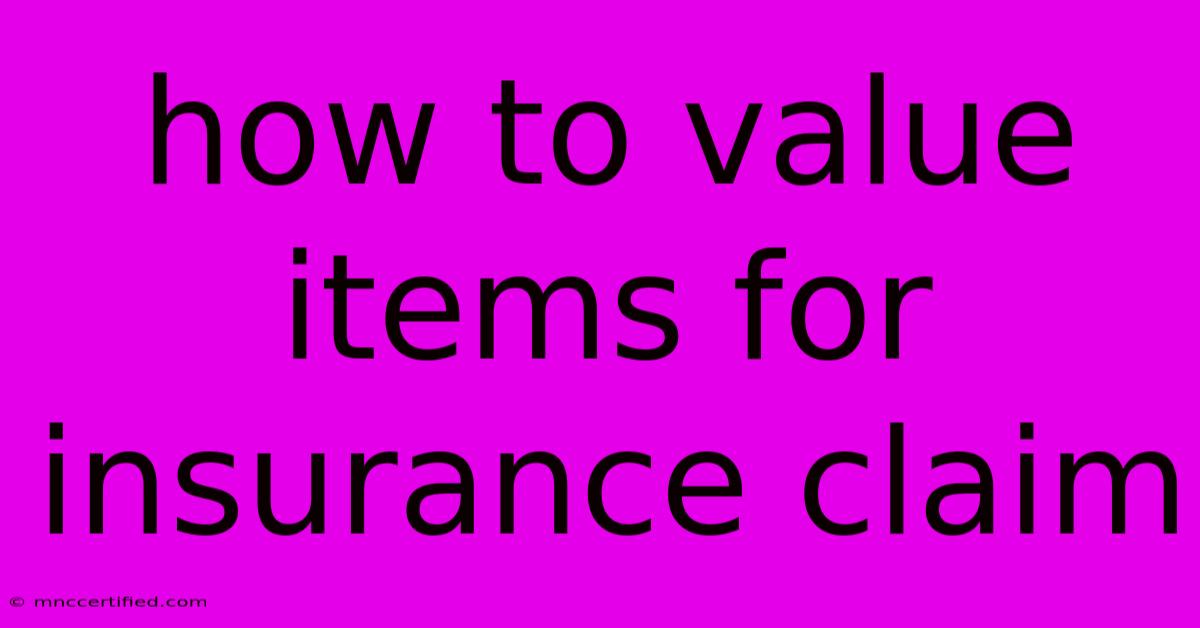How To Value Items For Insurance Claim

Table of Contents
How to Value Items for Your Insurance Claim: A Comprehensive Guide
Accidents happen. When they do, it's crucial to have adequate insurance coverage to help you recover. But how do you ensure your policy provides the right amount of protection? The answer lies in accurately valuing your possessions. This comprehensive guide will equip you with the necessary knowledge to effectively value your items for an insurance claim, maximizing your chances of a fair settlement.
Understanding the Importance of Valuation
Before diving into specific valuation methods, it's essential to grasp why accurate valuation is so critical. Underestimating the worth of your belongings can leave you undercompensated, potentially jeopardizing your financial recovery. Here's why accurate valuation matters:
- Fair Compensation: Insurance companies base their payouts on the value of your lost or damaged items. Accurate valuation ensures you receive fair compensation to replace or repair your possessions.
- Avoiding Disputes: A well-documented valuation process strengthens your claim and minimizes the likelihood of disputes with your insurer.
- Peace of Mind: Knowing your items are adequately insured provides peace of mind, allowing you to focus on recovering from the incident.
Valuation Methods: Choosing the Right Approach
Different items require different valuation methods. Here's a breakdown of common approaches:
1. Actual Cash Value (ACV):
- Definition: This method calculates the value of an item based on its current market value, taking depreciation into account.
- How it works: The insurer considers factors like age, condition, and wear and tear to determine the item's current value.
- Example: If you purchased a television for $1,000 five years ago and it's now worth $500 due to depreciation, your ACV payout would be $500.
2. Replacement Cost Value (RCV):
- Definition: This method considers the cost of replacing your item with a new, similar item, without accounting for depreciation.
- How it works: The insurer calculates the cost of purchasing a brand new item, regardless of the original purchase price.
- Example: Even if your five-year-old television is currently worth $500, RCV coverage would pay for a new, comparable television at its current market price, potentially $1,200.
3. Agreed Value:
- Definition: This method is typically used for valuable items like antiques, collectibles, and fine art.
- How it works: You and your insurer agree on a fixed value for the item before any claim arises. This ensures you receive the agreed-upon amount in case of loss or damage, regardless of market fluctuations.
- Example: You can agree with your insurer that a specific painting is worth $5,000, and you'll receive that amount if it's damaged or destroyed.
Valuing Your Items: A Step-by-Step Guide
Now that you understand the different valuation methods, let's explore practical steps to value your belongings:
1. Inventory Your Possessions:
- Create a detailed list: Document every item you want to insure, including its description, brand, model, and purchase date.
- Organize your inventory: Categorize your items based on their value and type (electronics, furniture, clothing, etc.).
- Take photos: Capture images of each item, including any damage or wear and tear. This visual documentation will be crucial in supporting your claim.
2. Gather Supporting Documentation:
- Receipts and warranties: These provide proof of purchase, original price, and any manufacturer's guarantees.
- Appraisals: For high-value items, obtaining professional appraisals from reputable sources like certified appraisers is essential.
- Estimates: If you're unsure about the value of a specific item, seek quotes from reputable repair or replacement services.
3. Utilize Online Resources:
- Retail websites: Compare prices for similar items on websites like Amazon, eBay, or specific manufacturer websites.
- Online valuation tools: Some websites offer free valuation tools for various items, like antique furniture or collectibles.
4. Consider Depreciation:
- Understand depreciation rates: Different items depreciate at varying rates. Research typical depreciation rates for the items you own.
- Factor in age and condition: The older and more worn an item is, the lower its value.
- Document repairs and maintenance: Any repairs or maintenance work you've performed on an item can impact its value.
5. Review and Update Regularly:
- Annual reviews: At least once a year, review your inventory and update any changes in values or new acquisitions.
- Life changes: Major life events, such as marriage, moving, or births, often involve changes in possessions. Update your inventory accordingly.
Additional Tips for Successful Valuation:
- Communicate with your insurer: Discuss your valuation methods with your insurance agent to ensure you understand their policies and requirements.
- Maintain detailed records: Keep all your documentation organized and readily accessible.
- Seek professional assistance: For high-value items or complex claims, consider hiring a public adjuster or claims specialist to assist you with valuation and negotiation.
Conclusion:
Accurate valuation is a cornerstone of successful insurance claims. By meticulously following the steps outlined in this guide, you can ensure your possessions are adequately protected and you receive fair compensation in the event of a loss. Remember, proactive valuation is essential for protecting your financial well-being.

Thank you for visiting our website wich cover about How To Value Items For Insurance Claim. We hope the information provided has been useful to you. Feel free to contact us if you have any questions or need further assistance. See you next time and dont miss to bookmark.
Featured Posts
-
Van Der Beek Shocked By Stage 3 Colorectal Cancer
Nov 09, 2024
-
Insurance Companies In Douglasville Ga
Nov 09, 2024
-
Tony Todd 1954 2024 A Legacy Remembered
Nov 09, 2024
-
As A Subcontractor Do I Need Insurance
Nov 09, 2024
-
Old Fitzgerald 10 Year Bottled In Bond
Nov 09, 2024